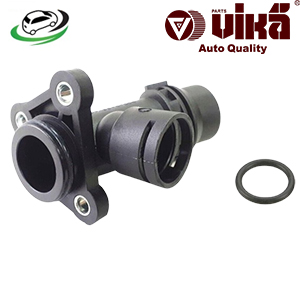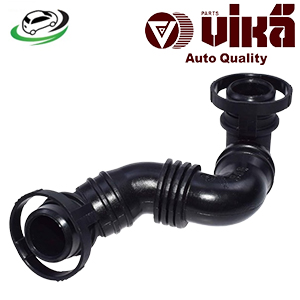-20%
Get Crankcase breather Vent Hose AUDI A3 8P / Volkswagen Golf MK5/Jetta/Passat 3C 06F103212D
The crankcase breather vent hose is a vital component in a vehicle’s engine system. Its primary function is to allow the release of gases and vapors that accumulate in the crankcase during engine operation. By managing these emissions, the breather vent hose plays a crucial role in maintaining engine performance, reducing harmful emissions, and prolonging engine life. Understanding its functionality, components, types, symptoms of failure, and maintenance is essential for vehicle owners and automotive technicians.
Functionality of the Crankcase Breather Vent Hose
The crankcase breather vent hose serves several important functions:
- Gaseous Emission Management: During engine operation, combustion gases and vapors can leak into the crankcase. The breather vent hose allows these gases to escape, preventing excessive pressure buildup within the crankcase.
- Prevention of Oil Leaks: By managing crankcase pressure, the vent hose helps prevent oil leaks and ensures that the engine remains sealed and lubricated properly.
- Reduction of Emissions: The vent hose often channels gases to the intake system or a PCV (Positive Crankcase Ventilation) valve, where they are reintroduced into the combustion process, reducing harmful emissions.
- Maintaining Engine Performance: Proper ventilation helps maintain the engine’s internal pressure balance, which is essential for optimal engine performance and efficiency.
Components of the Crankcase Breather Vent Hose
A typical crankcase breather vent hose system includes the following components:
- Vent Hose: The hose itself is usually made from durable rubber or silicone and is designed to withstand engine temperatures and pressures. It connects the crankcase to the breather assembly or intake system.
- Breather Valve: In some systems, a breather valve is included to regulate the flow of gases and vapors. It helps control the amount of pressure and prevents excessive buildup.
- Filter: Some breather systems include a filter that captures contaminants and prevents them from entering the engine or intake system.
- Clamps and Fittings: Clamps and fittings are used to secure the hose in place and ensure a tight seal between the hose, crankcase, and intake system.
Types of Crankcase Breather Vent Hoses
Crankcase breather vent hoses come in various designs, depending on the vehicle’s engine configuration and emission control requirements:
- Standard Rubber Hoses: These are commonly used in many vehicles and are made from flexible rubber that can withstand engine heat and pressure.
- Silicone Hoses: Silicone hoses offer increased durability and resistance to high temperatures and chemicals. They are often used in high-performance or heavy-duty applications.
- Braided Hoses: Some systems use braided hoses, which have a layer of reinforcement to provide additional strength and resistance to pressure.
- Integrated Breather Assemblies: In some designs, the breather vent hose is integrated with a breather assembly that includes additional components like filters or valves.
Symptoms of a Failing Crankcase Breather Vent Hose
Recognizing the signs of a failing crankcase breather vent hose is important for maintaining engine performance and avoiding potential damage:
- Oil Leaks: A damaged or clogged breather hose can cause excessive pressure to build up in the crankcase, leading to oil leaks around the engine seals and gaskets.
- Reduced Engine Performance: If the vent hose is clogged or damaged, it can affect the engine’s performance, causing issues like reduced power, rough idling, or poor acceleration.
- Increased Oil Consumption: A malfunctioning breather hose can lead to increased oil consumption as the engine struggles to maintain proper pressure balance.
- Check Engine Light: In some cases, a failing breather hose can trigger the check engine light on the dashboard, indicating a problem with the engine’s ventilation system.
- Excessive Smoke: If the breather system is clogged, it can lead to excessive smoke from the engine due to unburned gases being forced out of the crankcase.
Causes of Crankcase Breather Vent Hose Failure
Several factors can contribute to the failure of a crankcase breather vent hose:
- Wear and Tear: Over time, the hose material can degrade due to exposure to heat, oil, and engine vibrations. This can lead to cracks, leaks, or complete hose failure.
- Clogging: The hose can become clogged with debris, oil sludge, or contaminants, reducing its effectiveness and causing pressure buildup in the crankcase.
- Improper Installation: Incorrect installation or loose fittings can lead to leaks or poor performance of the breather system.
- Exposure to Chemicals: Exposure to harsh chemicals or solvents can damage the hose material, leading to premature failure.
Maintenance and Replacement
Proper maintenance of the crankcase breather vent hose involves regular inspections and timely replacements to ensure optimal engine performance:
- Regular Inspections: Periodically check the vent hose and associated components for signs of wear, damage, or clogging. Look for cracks, leaks, or oil buildup around the hose.
- Follow Manufacturer’s Recommendations: Adhere to the manufacturer’s recommended maintenance intervals and replacement schedules for the breather hose. This information can be found in the vehicle’s owner’s manual.
- Replace as Needed: If any symptoms of a failing breather hose are observed, or if the hose is damaged or clogged, replace it promptly to maintain proper engine ventilation and performance.
Replacement Process
Replacing a crankcase breather vent hose typically involves the following steps:
- Prepare the Vehicle: Ensure the engine is off and has cooled down. Open the hood and locate the crankcase breather vent hose.
- Remove the Old Hose: Disconnect the hose from the crankcase and the intake system or breather assembly. Remove any clamps or fittings securing the hose in place.
- Install the New Hose: Position the new hose and secure it with the appropriate clamps or fittings. Ensure the hose is properly aligned and connected to the crankcase and intake system.
- Check for Leaks: Start the engine and inspect the hose connections for any signs of leaks or improper sealing. Ensure the engine runs smoothly and there are no issues with performance.
- Test the Vehicle: Verify that the engine is operating correctly and that there are no abnormal noises or symptoms related to the breather system.
Importance of Quality Crankcase Breather Vent Hoses
Using high-quality crankcase breather vent hoses is essential for several reasons:
- Performance: Quality hoses provide effective ventilation, ensuring optimal engine performance and reducing the risk of oil leaks or other issues.
- Durability: High-quality materials and construction enhance the hose’s longevity, reducing the need for frequent replacements and preventing premature failure.
- Reliability: Reliable hoses ensure consistent performance of the engine’s ventilation system, maintaining proper pressure balance and reducing the risk of engine damage.
- Cost-Effectiveness: Investing in a quality breather hose can prevent costly repairs and maintain overall vehicle efficiency.
Follow us on Facebook for more parts.



